Sikorsky S-76C++
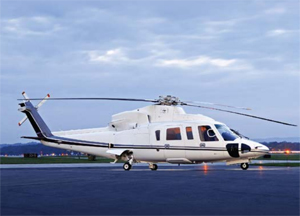
Photo copyright Lockheed Martin - used with permission
Petroleum Helicopters, N748P
Morgan City, Louisiana
January 4, 2009
On January 04, 2009, a Petroleum Helicopters, Inc. (PHI) S-76C++ helicopter crashed seven minutes after departure from its home base of Amelia, LA. The helicopter was enroute to an offshore oil rig helipad. Weather at the time of the accident was clear with ten miles visibility. The helicopter crashed in remote, marshy terrain after experiencing a loss of control event, descending rapidly, and impacting the ground. The pilot, copilot, and six of the seven passengers were killed.
The aircraft was equipped with a combination cockpit voice recorder (CVR) and flight data recorder (FDR). Flight recorder data indicated that the helicopter was in level cruise flight at 850 feet mean sea level (MSL) and traveling at 135 knots. Analysis of the audio recordings revealed a loud "bang" which was immediately followed by sounds consistent with "rushing wind." Subsequent to the power loss, the flight crew lost control of the helicopter, resulting in the crash.
The National Transportation Safety Board (NTSB) determined that the accident was the result of a collision with a red-tailed hawk that fractured the windshield and moved the engine power levers to a low power/idle position. The crew members were likely disoriented following the collision and were unable to recover from the loss of power.
NTSB Accident Number: CEN09MA117
History of Flight
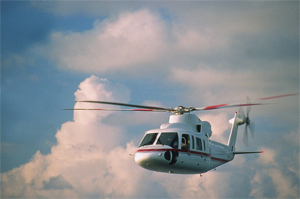
Photo copyright Lockheed Martin - used with permission
On January 4, 2009, a PHI Sikorsky S-76C++ departed Lake Palourde Base Heliport at 1402. The helicopter was en route to an offshore oil platform with two pilots and seven passengers. Seven minutes after departure, while in cruise flight at 850 feet mean sea level and an indicated air speed of 135 knots, the cockpit voice recorder recorded a "loud bang," followed by sounds consistent with "rushing wind." An immediate power reduction on both engines was followed by a rapid decay of main rotor RPM (revolutions per minute). The helicopter departed controlled flight and rapidly descended and crashed into marshy terrain. The pilots, and six of the seven passengers were killed. One passenger was seriously injured.
The PHI communications center did not receive a distress call or emergency transmission from the flight. A search and rescue operation was initiated at 1414 after the U.S. Air Force received an emergency locator transmitter (ELT) distress signal with the helicopter's unique identifier and location. Approximately 20 minutes after the crash, the United States Air Force Rescue Coordination Center (USAFRCC) notified PHI and the United States Coast Guard (USCG). A USCG helicopter located the wreckage and performed a rescue operation to extract the surviving passenger.
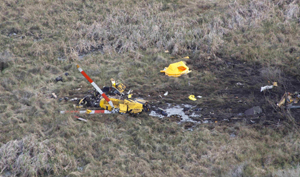
Following recovery of the wreckage, it was examined by accident investigators. Investigators determined that both sections of the cast acrylic windshield were shattered. The windshield assembly consists of left and right (copilot and pilot) sections separated by a center post. Initial visual inspections on-site did not reveal any evidence of a bird strike; however, the windscreen did exhibit concentric ring fractures which can indicate an impact to the windscreen.
Subsequent investigation determined that the helicopter had collided with a red-tailed hawk. The helicopter crashed just 17 seconds after the bird strike and seven minutes after takeoff.
An animation of the accident events is available below:
Detailed examination of the airframe surrounding the windscreen revealed feathers and other bird remains. Samples were obtained from the canopy, at the apparent point of impact, the windshield and from other locations on the exterior of the helicopter. Laboratory analysis was accomplished by the Smithsonian Institution Division of Birds, which identified the remains as coming from a female red-tailed hawk. The female red-tail hawk has an average weight of approximately 2.4 pounds.
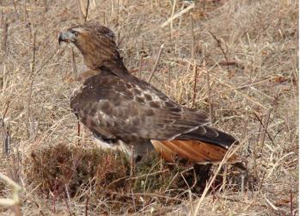
No defects in the materials, manufacturing, or construction of the windscreen were observed. A search of maintenance records did not indicate the presence of any preexisting damage that might have caused the windshield to shatter. A detailed windshield examination revealed fractures at the top of the right section of the windshield and damage to the canopy in that area. Investigators concluded that this damage was consistent with a bird impacting the canopy just above the top edge of the windshield. This resulted in structural deformation and ultimate failure of the canopy structure. All other fractures observed in other areas of the windshields were caused by ground impact.
The NTSB's Materials Laboratory examined the fractured windshields from the accident helicopter and found that all of the fractures were typical of brittle overstress. Many of the windshield fragments were large and sharp-edged. The windshield was made from monolithic cast acrylic. Investigators determined that the location of the bird impact deformed the fuselage and surrounding structure in the area of the engine control quadrant, likely jarring the fire extinguisher T-handles out of their detents and moving them aft. This aft movement then moved both engine power control levers (ECL) triggers out of their stops, moving them aft and into or near the flight-idle position.
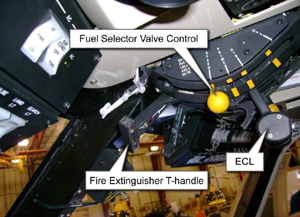
Engine Controls
The S-76C++ helicopter was designed with engine controls on the overhead quadrant, accessible by both pilots. The quadrant also houses two engine fire extinguisher T-handles and two engine power control levers. The fire extinguisher T-handles are approximately four inches aft of the captain's and first officer's windshields. While in cruise flight, the fire extinguisher T-handles are positioned full-forward. Each handle is secured by a spring-loaded retaining pin which engages a detent. Moving the T-handles from the flight position detents requires an aft pull force. Aft movement of the T-handles also engages a mechanical cam on each T-handle which moves a trigger on the associated ECL out of its stop, freeing the ECL to move aft and reducing fuel to the associated engine.
In the event of an engine fire, the T-handle is moved aft, which also moves the ECLs aft, reducing fuel to the engines. Based on examination of the wreckage, investigators believed the hawk struck the canopy, above the windshield on the right side near the T-handles, subsequently moving them out of their detents and pushing both ECLs out of their stops. The investigation determined that the loss of control was the result of the rapid migration of the engine power levers out of their detent position and rapid loss of rotor speed associated with the unplanned power reduction.
Windshield
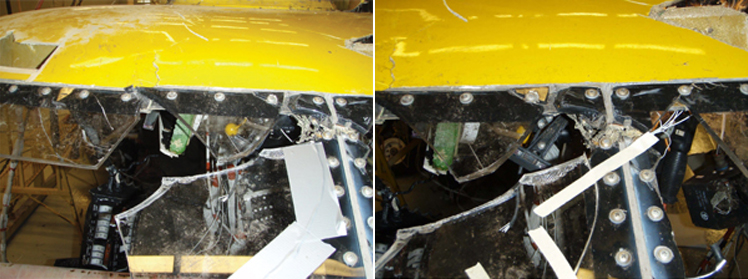
Investigators determined that the windshields were not the original equipment manufacturer (OEM) windshields that had been delivered with the aircraft from the factory. Maintenance records identified that PHI had replaced the original laminated glass windshields delivered on the accident helicopter with after-market cast acrylic windshields about two years before the accident. Installation of these after-market windshields on PHI's S-76 fleet provided a weight savings relative to the OEM windshields. The weight saving was due to the reduced weight of the windshield and removal of associated windshield heating equipment. Investigators also noted that PHI had again replaced several of these after-market windshields on their fleet of helicopters about one year before the accident, due to cracking at fastener holes. At the time of the accident in January 2009, PHI had a fleet of 46 S-76's, all of which were equipped with monolithic cast acrylic windshields.
Aeronautical Accessories Incorporated (AAI) designed and produced the after-market windshields, and in November 1996 applied for supplemental type certificate (STC) approval from the Federal Aviation Administration (FAA) for installation on the S-76. The STC was subsequently issued in April 1997. The certification basis for the S-76C++, based on amendments 1 through 11 of 14 CFR part 29, which were in effect at the time of the original TC, had not required bird-impact capability. In August of 1996, 14 CFR 29.631 Bird Strike was adopted. Several months later AAI applied for the STC incorporating the acrylic windshield. Investigators could not determine if compliance with 29.631 had been demonstrated during the windshield certification process.
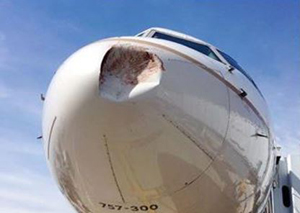
Bird Hazards to Aircraft
The FAA began collecting bird strike data in 1965 in order to determine general trends related to bird encounters and to aid in development of new rules for turbine engines and transport category airplanes. In 1995, the FAA, in cooperation with the United States Department of Agriculture, Wildlife Services (USDA/WS), created the National Wildlife Strike Database in order to collect and analyze wildlife strike data. These data are annually compiled into a report, Wildlife Strikes to Civil Aircraft in the United States. The 22nd issuance of this report (1990-2015) is available at the following link: (Wildlife Strike Report).
According to the report, bird strikes continue to pose a significant threat to aviation worldwide. Between 1988 and 2014, bird and other wildlife strikes resulted in the loss of 245 airplanes and helicopters and 258 deaths internationally.
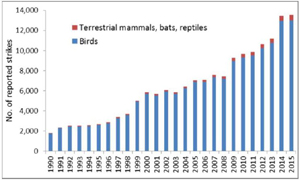
National Wildlife Strike Database – 2015 Report
View Larger
Threat Increasing
According to the report, between 1990 and 2015 there were 166,276 reported wildlife strikes in the U. S., distributed among all aircraft types and operations - commercial, small aircraft, and rotorcraft. Of these encounters, 95.8% involved birds, with the remainder involving bats or terrestrial mammals/reptiles. The severity of a bird encounter can be a function of aircraft size and speed, bird size, and the number of birds involved in each encounter. The threat potential for bird encounters can vary seasonally, regionally, as a function of proximity to airports, and by the number of aircraft operations conducted in high threat areas.
In the U. S., many large birds have increased in population, and adapted to life in urban areas, including near airports. Concurrent with this increase in the number of birds, commercial aviation continues to grow, resulting in an increase in the numbers and frequencies of bird encounters. As examples, the National Wildlife Strike Database illustrated the increase in strikes involving red-tailed hawks and snow geese. In addition, significant population increases have been reported for bald eagles, vultures, ospreys, peregrine falcons, and others.

View Larger
Factors Influencing Risk
Altitude
According to data in the FAA Wildlife Strike Database, there are a number of factors that can influence the potential for a bird strike. Seventy-three percent of bird strikes occurred at 500 feet or less, and 97% occurred below 3,500 feet. For general aviation, above 500 feet, the number of reported strikes was consistently reduced by 44% per each thousand feet of altitude increase. Risk of a strike decreases exponentially with increasing altitude.

Chart showing general aviation number of damaging strikes above/below 1,500 feet AGL (right)
National Wildlife Strike Database – 2015 Report
View Larger
Bird Mass
At any given airspeed, the mass of a bird has an effect on the energy transferred during a collision and the extent of damage that may occur. Kinetic energy (mV2/2) is a direct function of the speed and mass. The FAA Wildlife Strike Database indicates that although the probability of a bird strike is reduced as altitude increases, due to the energies involved, about 50% of bird strikes at any altitude result in damage. The kinetic energy associated with a strike is essentially unaffected by altitude, and is more directly a function of the mass and relative impact speed of the bird and aircraft. Between 1990 and 2015, 36 aircraft were destroyed (or damaged beyond repair) as a result of bird strikes.

Chart of total number of aircraft destroyed by wildlife strikes – 68 Total 36 involving birds (right)
National Wildlife Strike Database
View Larger
Seasonal Effects
Nationally, according to the National Wildlife Strike Database, between 1990 and 2014, the highest bird strike rate occurred in late summer/early fall and the lowest rate occurred in winter. Bird migration seasons have an effect on the frequency of strikes. Fifty-three percent of bird strikes occur between July and October.

Photo of US Airways flt #1549, January 15, 2009, following dual engine failure due to geese ingestion into both engines. (right)
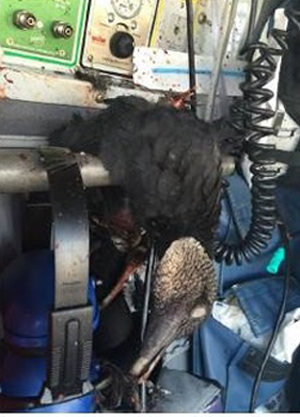
2015 Wildlife Strike Report
Bird Strikes to Helicopters
The FAA's Wildlife Strike Database indicates a 68% increase in bird strikes since 2009 and more than a 700% increase since the early 2000's in the rotorcraft event data. These percentages represent an increase from approximately 25 reports of rotorcraft bird strikes per year in the early 2000's, to 121 strikes in 2009, and 204 strikes in 2013. Implementing a rotorcraft rate-based analysis, the reported bird strikes increased from 3.99 per 100,000 flight hours to 5.95 per 100,000 flight hours, a 49% increase in the five-year period from 2010 to 2014. An improved event reporting system accounts for a portion of this increase, but the rapid increase goes beyond the reporting improvements alone. It is often attributed to a growing population of birds in general, a growing population of larger birds, quieter aircraft, and an increase in the number of rotorcraft operations.
These recent observations reinforce previous findings from the study, Bird Strikes to Civil Helicopters in the United States, 1990-2005 (2006), by Cleary, Dolbeer, and Wright, based on 15 years of data from the FAA's National Wildlife Database. The study concluded that:
(1) Helicopters were significantly more likely to be damaged by bird strikes than airplanes
(2) Windshields on helicopters were more frequently struck and damaged than windshields on airplanes
(3) Helicopter bird strikes were more likely to lead to injuries to crew or passengers than airplane bird strikes
(4) Flight crew use of protective equipment, such as helmets and visors can aid in reducing injuries
The study from which these data are derived: Wildlife Strikes to Civil Aircraft in the United States 1990-2005 is available at the following link. (Wildlife Strikes 1990-2005). The data relevant to helicopters are contained in Appendix A of this report.
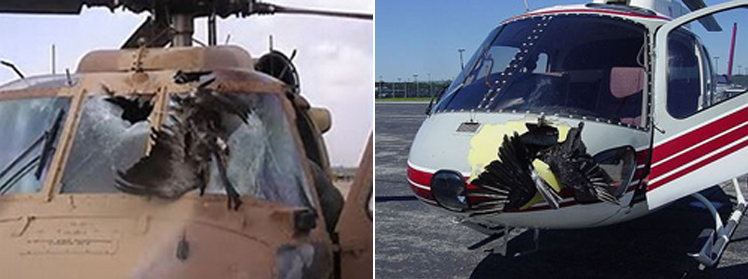
Aircraft Certification Requirements
Design Certification Basis
The design certification basis is the "set" of certification regulations to which a manufacturer/modifier must demonstrate compliance. When a manufacturer/modifier applies for a Type Certificate (TC) or Supplemental Type Certificate (STC), the applicable regulatory basis is established by application of 14 CFR Part 21 - Certification Procedures for Products and Parts. Further, 14 CFR 21.17, - Designation of Applicable Regulations for type certificates and 14 CFR 21.115, Applicable Requirements for supplemental type certificates outline the methods by which the certification is established. In the case of the windshield STC, 21.115 incorporates the requirements of 21.101 to establish the certification basis for the changed area. In general, the rules in effect at the date of application for the change, that is, the amendment levels of 14 CFR Parts 23, 25, 27, or 29, etc., in effect on the application date establish the certification basis.
For changes to a TC or STC, 14 CFR 21.101 - Designation of Applicable Regulations becomes the applicable regulation for establishing the certification basis for the changed area. In general, as for the basic type or supplemental type certification, the regulatory amendment in effect at the time of application defines the certification basis for the change.
Designation of applicable regulations.
(a) Except as provided in [Secs. 23.2, 25.2, 27.2, 29.2] and parts 34 and 36 of this chapter, an applicant for a change to a type certificate must comply with either--
(1) The regulations incorporated by reference in the type certificate; or
(2) The applicable regulations in effect on the date of the application, plus any other amendments the administrator finds to be directly related.
S-76 Type Certification
During the investigation, the NTSB examined the FAA certification basis for both the S-76C++ and the monolithic cast acrylic windshield that had been installed via STC. The S-76C++ largely retained the certification basis that had been applied to the original S-76 certification in 1977. The certification basis was established as Amendments 1 through 11 of 14 CFR Part 29, Airworthiness Standards: Transport Category Rotorcraft. At the time of the original certification, there were no FAA requirements for bird strike resistance for the helicopter. Investigators determined that neither windshield installation - the original S-76C++, or the cast acrylic windshield installed via STC, were required to meet any FAA bird impact standards. However, at a later date, in order to comply with UK import requirements, investigators learned that Sikorsky had performed bird impact tests on the original equipment windscreen. The windscreen originally delivered on the S-76C++ was demonstrated to be compliant with British Civil Aviation Requirements (BCAR), which required the windscreen to resist penetration of a two-pound bird at certain flight conditions.
Bird Strike Requirements
On August 8, 1996, the FAA adopted 14 CFR 29.631, Bird Strike, as amendment 40 to 14 CFR Part 29, which required the helicopter to withstand the impact of a 2.2-pound bird at a specified flight speed.
Bird strike.
The rotorcraft must be designed to ensure capability of continued safe flight and landing (for Category A) or safe landing (for Category B) after impact with a 2.2-pound (1.0 kg) bird when the velocity of the rotorcraft (relative to the bird along the flight path of the rotorcraft) is equal to VNE or VH (whichever is the lesser) at altitudes up to 8,000 feet. Compliance must be shown by tests or by analysis based on tests carried out on sufficiently representative structures of similar design.
Monolithic Cast Acrylic Windshield
In November 1996, AAI applied for an STC to replace the OEM windshield on the S-76 with a monolithic cast acrylic windshield. The STC was issued in April 1997. Investigators noted that, based on the application date of the STC, compliance with 14 CFR 29.631 should have been included in the certification basis of the STC. It was concluded that compliance would have required that the cast acrylic windshield be capable of withstanding the impact of a 2.2-pound bird.
Investigators could not establish that compliance with this regulation had been demonstrated during the STC windshield certification process. The accident report stated, "the STC data package...revealed no documentation to indicate ...compliance with 14 CFR 29.631."

Conclusion
Birds continue to pose a significant threat to helicopter operations. In recent years, bird populations for many species have been increasing, as has the numbers of aircraft and aircraft in operations. This combination results in an ever-increasing bird strike threat. Bird strike data also indicate that helicopters are more frequently involved in bird strikes than other types of aircraft, and those strikes generally result in more damage to the aircraft and injury to crew or passengers. In order to reduce the hazard, later certification regulations have adopted bird impact standards for transport category helicopters. In addition to continual adoption of newer (or improved) certification standards, multiple data studies related to bird strikes have concluded that operational mitigations, such as flight at higher altitudes, and flight crew use of protective equipment for head and eyes, can be employed to help reduce the threats or consequences of bird strike events.
The NTSB determined the probable causes of the accident to be:
- the sudden loss of power to both engines that resulted from impact with a bird (red-tailed hawk), which fractured the windshield and interfered with engine fuel controls, and
- the subsequent disorientation of the flight crewmembers, which left them unable to recover from the loss of power. Contributing to the accident were (1) the lack of FAA regulations and guidance, at the time the helicopter was certificated, requiring helicopter windshields to be resistant to bird strikes; (2) the lack of protections that would prevent the T-handles from inadvertently dislodging out of their detents; and (3) the lack of a master warning light and audible system to alert the flight crew of a low rotor-speed condition.
Other than the stated probable cause, the NTSB did not issue any formal findings. Two reports were issued: the final report and a brief initial report. The complete final accident report is available at the following link: (CEN09MA117).
The brief report is available at the following link: (NTSB Brief Report).
The NTSB issued 12 recommendations, transmitted to the FAA via letter. The subjects of the recommendations ranged from the design of the engine controls to regulatory requirements for the certification of helicopters. The recommendations as transmitted from the NTSB are included below:
"The National Transportation Safety Board recommends that the Federal Aviation Administration:
- Require that Sikorsky redesign the S-76C++ model helicopter fire extinguisher T-handles and/or engine control quadrant to ensure that the T-handles do not inadvertently dislodge out of their detents due to any external force on the canopy or windshields that could cause unintended movement of the engine power control levers. (A-10-136)
- Evaluate other helicopter models with engine control quadrant designs similar to the S-76C++ model helicopter and require modification, as necessary, to ensure that any external force on the canopy or windshields does not cause unintended movement of the engine power control levers. (A-10-137)
- Issue a certification policy to require that operators of helicopters with windshields with demonstrated bird-strike resistance not be permitted to replace those windshields with ones that have not been demonstrated to be resistant to bird strikes. (A-10-138)
- Evaluate the feasibility of retrofitting helicopters manufactured before 1996 with windshields that meet the current bird-strike requirements. (A-10-139)
- Evaluate the feasibility of requiring manufacturers to equip new helicopters, built under the old certification requirements, with windshields that meet the current bird-strike requirements. (A-10-140)
- Require helicopter manufacturers to develop helicopter-specific guidance (based on the helicopter's demonstrated capability to withstand a specific level of bird-strike impact energy) that will assist pilots in devising precautionary helicopter operational strategies for minimizing the severity of helicopter damage sustained during a bird strike, should one occur, when operating in areas of known bird activity. (A-10-141)
- Require Sikorsky to design an audible low rotor revolutions per minute (Nr) alarm system and master warning light that will alert the flight crew of S-76 model helicopters of rapidly decaying Nr. (A-10-142)
- Once an audible low rotor revolutions per minute (Nr) alarm system and master warning light are designed as requested in Safety Recommendation A-10-142, require operators of Sikorsky S-76 model helicopters to install the audible low Nr alarm system and master warning light that will alert flight crews of rapidly decaying Nr. (A-10-143)
- Revise 14 Code of Federal Regulations 27.33 and 29.33 to require an audible low rotor revolutions per minute alarm system and master warning light for all dual-engine helicopters, even those that are equipped with a device that automatically increases power on the operating engine when the other engine fails. (A-10-144)
- Require operators to include simultaneous dual-engine power loss scenarios in both initial and recurrent ground and simulator training for pilots of dual-engine helicopters. (A-10-145)
- Update the 14 Code of Federal Regulations Part 29 transport-category helicopter bird-strike standards so that they are consistent with the latest military and civilian bird-strike database information and trends in bird populations. (A-10-146)
- Revise 14 Code of Federal Regulations Part 27 to specify a bird weight and velocity of impact that the helicopter must withstand and still be able to land safely and that the windshield must withstand without penetration. Consider current military and civilian bird-strike database information and trends in bird populations in drafting this revision. (A-10-147)"
The letter transmitting the recommendations to the FAA is included at the following link: NTSB Safety Recommendations.
14 CFR Part 21 Certification Procedures for Products and Parts (Part 21) performs multiple functions, including definition of the processes by which aeronautical products are certified. When a manufacturer/modifier submits an application for a TC or STC, Part 21 establishes the processes that must be followed and the regulations for which compliance must be demonstrated. At TC or STC application, the set of applicable regulations is defined and, in general, remains static for the life of the product.
The various CFR parts, the safety standards associated with airplane or rotorcraft design, are amended on a regular basis, generally to increase the level of safety associated with regulatory requirements. As regulations evolve, an original product is not normally required to comply with later amendments to the applicable regulations. However, if a manufacturer/modifier makes application to change a certified product, with few exceptions, the changed product is required to show compliance to the regulations in effect at the time of application for the changed areas. Various regulations contained in Part 21 define the certification processes, for any aeronautical product, for which compliance must be demonstrated before a TC or STC is issued.
In this accident, a windshield manufacturer applied for an STC to install a monolithic cast acrylic windshield in place of the OEM's laminated glass windshield. The original certification basis for the helicopter did not include a requirement for bird impact-resistance. During the investigation it was learned that the OEM windshield provided a level of bird impact-resistance that was found to comply with BCAR requirements for export and use in North Sea operations. Shortly before STC application, the FAA adopted 14 CFR 29.631 which implemented a bird strike requirement. This regulation was not retroactively applied to the OEM helicopter. Investigators concluded that the new regulation should have been made applicable to the STC certification basis for the monolithic cast acrylic windshield.
Regulatory and guidance material related to this accident, at the appropriate amendment levels, is provided in this section.
Regulations
14 CFR 21.17 Designation of applicable regulations
This regulation was in effect at the time of application for the original type certificate (H1NE) on the S-76 and established the original certification basis. Follow-on derivative models, including the S-76C++, used largely the same certification basis, except for areas that were substantially different than the original design and required compliance with newer regulatory amendments. Since the original windscreen was not changed as part of the type design, the certification basis for the OEM windshield was not changed for derivative models. At the time of application for the original TC, there were no bird strike requirements applicable for the helicopter.
14 CFR 21.115 Applicable requirements
This regulation was in effect at the time of application for the windshield STC (installation of the monolithic cast acrylic windshield.) This regulation pertains to STCs, but has the same effect as 21.17, in that it establishes the certification basis for the STC. This regulation also invokes the requirements of 21.101 which requires the adoption of the regulations in effect at the time of application that are directly applicable to the changed areas identified in the STC application.
14 CFR 21.101 Designation of applicable regulations
Policy material associated with this regulation explains that 21.101 was adopted as a means to "enhance safety by incorporating the latest requirements into the type certification basis for the changed product to the greatest extent practicable." The original version of this regulation was adopted in 1965. The regulation establishes a means to identify the applicable regulations and their appropriate amendment levels when defining the certification basis of a changed or modified product.
Adopted at Amendment 40 to Part 29 in August 1996, this regulation-imposed bird strike requirements for transport category helicopters. The regulation specified that the helicopter must be capable of withstanding the impact of a 2.2-pound bird at a specified speed. This regulation, though not part of the certification basis for the original helicopter, became effective several months prior to AAI's application for the windshield STC. Investigators determined that this regulation should have been included in the certification basis of the STC windshield. However, investigators could not determine that compliance to this regulation had been demonstrated as part of the windshield certification process.
Advisory Circulars
AC 21.101-1B Establishing the Certification Basis of Changed Aeronautical Products
This advisory circular was written to provide guidance in establishing the certification basis of a changed aeronautical product. The introduction states, "The guidance is intended to help applicants and delegated organizations determine if it will be necessary to apply for a new type certificate (TC) under § 21.19, Changes requiring a new type certificate. The guidance also describes the process for establishing the certification basis for an amended TC, supplemental type certificate (STC), and amended STC, detailing the requirements (evaluations, classifications, and decisions) throughout the process."
Sikorsky, the helicopter manufacturer, marketed the S-76 to North Sea offshore operators. As an export requirement, Sikorsky had qualified the original equipment laminated glass windscreen to meet British Civil Airworthiness Requirements (BCAR), which at the time included bird strike requirements to withstand impact with a 2-pound bird.
Investigators reviewed the FAA certification process and could find no record that compliance with 14 CFR 29.631 had been required by the FAA or demonstrated during the STC process that culminated in approval of the cast acrylic windscreen installation. The accident report further stated that 14 CFR 29.631 should have been included in the certification basis for the STC.
- Bird Strike to the helicopter canopy leading to inadvertent movement of the engine control levers, associated rapid power loss, and subsequent loss of control.
In the service history of the Sikorsky S-76, bird strike events had occurred and resulted in damage to the fuselage or windscreen penetration, causing minor injuries, and requiring precautionary landings. However, there had never been a catastrophic failure in helicopter aviation of the magnitude of this accident, resulting from a bird impact.
- Cruise operations at relatively low altitude in high bird threat area.
Bird populations and helicopter operations are both increasing, which can result in an increased probability of bird strikes if cruise operations are conducted at relatively low altitudes.
- Historically, birds did not pose a significant safety risk to helicopter operations. Therefore, bird impact safety standards were not necessary for transport category helicopters.
- Subsequent to August 1996, part 29 helicopter certification programs certification basis for type, and supplemental type certificates would incorporate the bird strike requirements of amendment 40.
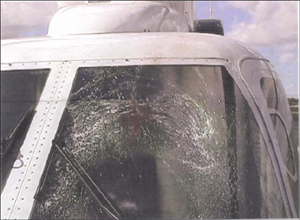
On November 13, 1999, an incident occurred in West Palm Beach, Florida, where a bird struck the windshield of an S-76C+ helicopter. The bird later identified as a turkey vulture did not penetrate the laminated glass windshield. The turkey vulture has an average weight of approximately 1.8 to 5.1 pounds. The impact forces cracked the windshield and moved the fire extinguisher T-handles out of their detents; but not with sufficient force to move the engine condition levers.
In 2006, a PHI S-76 helicopter with a monolithic cast acrylic windshield experienced a bird-strike incident. Post-incident examination revealed a near-circular hole with radiating cracks near the top center of the right windshield. The bird had penetrated the windshield and pushed the right-side T-handle. The trapped remains of the bird prevented the right-side throttle from being reengaged, but the pilot was able to land the helicopter safely.
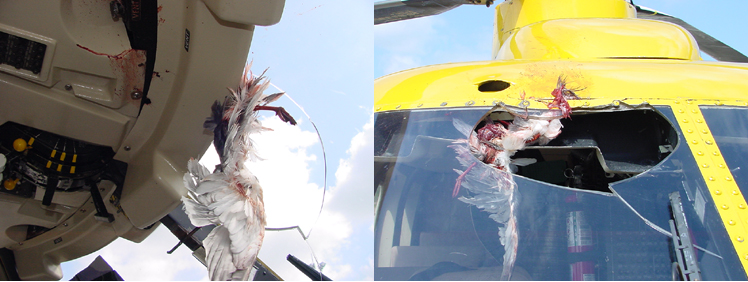
- Redesign of Engine Condition Levers
The design of the original ECL was modified by installing an improved throttle stop and a wider trigger. This redesign was mandated in Airworthiness Directive 2012-22-13. The investigation discovered that a bird-strike to the windshield area of the helicopter resulted in unintended movement of the engine control levers from the forward position and towards the flight-idle position, which reduced power on both engines. This redesign was intended to prevent inadvertent movement of the ECLs, which could result in main rotor speed decay and subsequent loss of control of the aircraft.
This recommended practice was disseminated to all helicopter operators. The HSAC - RP recommends operational means (primarily flight at higher altitudes) by which to reduce the probability of a bird strike.
This AD requires the installation of an improved throttle stop and a wider trigger on the engine control levers. These actions are intended to prevent unintended movement of the ECLs, which could result in main rotor speed decay and subsequent loss of control of the helicopter.
Rotorcraft Life Cycle:
- Design / Manufacturing
- Operational
- Maintenance / Repair / Alteration
Accident Threat Categories:
- Bird (BIRD)
- Loss of Control-Inflight (LOC-I)
Industries:
- Offshore
Accident Common Themes:
- Organizational Lapses
Organizational Lapses
14 CFR 21.101 requires that the certification basis of a changed aeronautical product be established based on the regulations in effect on the date of application for the change. Investigators noted that 14 CFR 29.631 became effective in August 1996, and the STC application for the monolithic cast acrylic windshield was submitted in November 1996. Investigators concluded that based on the date of application, 29.631 should have been included in the certification basis for the STC. Investigators further noted that no certification record could be found that indicated compliance with 29.631 had been demonstrated.
The entire inventory of related accidents/incidents occurred prior to this accident and are discussed in the Precursors section of this accident module.
Technical Related Lessons
Bird populations and exposure to bird strike threats can vary greatly on a seasonal basis and by geographic region. In high threat areas, or during high threat periods, the possibility of a bird strike is significantly increased. (Threat Category: Bird)
- This accident was the result of a bird strike at an altitude of approximately 850 feet. The accident occurred in an area (coastal wetlands) that hosted a large bird population, and therefore posed a higher bird strike threat than other geographic regions may have posed at the same time of year. The accident report quoted the FAA's Bird Strike Reporting Database, stating that helicopters are significantly more likely to be damaged by bird strikes, helicopter windshields are more frequently struck and damaged than those on airplanes; and helicopter bird strikes are more likely to lead to injury of crew or passengers.
- The accident report noted, and scientific reports have indicated, that certain precautions can reduce the potential for a bird strike and significantly increase the level of safety associated with flight through high threat areas. Absent physical changes to an aircraft to make it more strike resistant as well as seasonal modifications to flight profiles, as an example, might be a feasible precaution that can reduce the possibility of a bird strike.
The safety threat associated with a bird strike is a function of the kinetic energy at impact. In high threat areas, operational means to mitigate the threats (such as seasonal modifications to flight profiles - altitude/speed/track) may provide safety benefits. (Threat Category: Bird)
- This accident was the result of a collision with a ted-tailed hawk, a species that can weigh between 1.5 and 3.5 pounds. A 100-knot collision can result in impact (kinetic) energies (mV2/2) of almost 50,000 foot-pounds. If airspeed is increased to 250 knots, the impact energy can increase to over 300,000 foot-pounds. Investigators determined that the bird impacted the airframe just above the windscreen, resulting in structural deformation of the canopy, fracturing the windscreen and moved the engine condition levers, resulting in a loss of power, and subsequent loss of control of the helicopter. Investigators determined that the loss of control was the result of the sudden loss of power and did not establish that the fracture of the windshield was a primary cause of the accident.
Rotorcraft bird impact capability can provide enhanced protection. (Threat Category: Bird)
- During cruise flight at an altitude of approximately 850 feet, the accident helicopter struck a red-tailed hawk. The impact occurred on the canopy, just above the windscreen, causing deformation to the canopy, and fracturing the windscreen. At the time of the original S-76 helicopter certification, there were no bird impact requirements for the helicopter. Further, investigators learned that the windscreen installed via STC was also not required to comply with bird impact requirements which had been adopted by the FAA just prior to application for the windscreen STC. Neither windscreen installation was required to meet any bird impact requirements.
Impact threats posed by some large birds can exceed the capability of any aircraft component or structure, such as windscreens, flight controls, etc. Operational precautions can be employed to mitigate the effects and minimize the likelihood of a bird strike. (Threat Category: Bird)
- While in cruise flight at 850 feet, the accident helicopter struck a red-tailed hawk, which can range in weight from 1.5 to as high as 3.5 pounds. Historically, aviation bird strike records have documented strikes involving birds as large as 16 pounds (whistling swan) or more. High speed impacts with birds of this size can result in extensive damage to any aircraft, potentially leading to the loss of the aircraft due to loss of control, or structural failure. In addition to compliance with regulatory standards for bird impacts, there are other operational precautions that can mitigate the potential for bird impacts. Additionally, many airports have undertaken programs to reduce or control bird activity.
- The National Wildlife Strike Database of November 2016 identified a strong correlation between altitude above the ground (AGL) and bird strike frequency. Above 500 feet, the number of reported strikes declined by 44% for each thousand feet of altitude increase. Modification of flight profiles, employing modest increases in cruise altitudes can have a significant beneficial effect on the probability of experiencing bird strikes. For example, a 1,000-foot AGL cruise altitude results in a probability of a bird strike that is approximately10 times more likely than at 3,000 feet. Further, use of crew protective equipment (helmets and visors) can reduce or mitigate the consequences should a bird strike occur.
Common Theme Related Lessons
The "set" of regulations encompassed in the certification basis for any changed aeronautical product is generally determined based upon identification of the regulations in effect on the date of application for the change (Common Theme: Organizational Lapses).
- 14 CFR 21.101 defines the process for determining the certification basis of any changed aeronautical product. In general, the certification basis is determined by applying the airworthiness requirements in effect (amendment levels) at the time of application for the change. Current policy allows two exceptions to be considered:
- The changed product complies with an earlier version of a regulation, and compliance with the later amendment of the same regulation will not yield a material increase in safety or;
- Incorporation of the current regulation is impractical.
- When an OEM develops a derivative model of a certified type design, that OEM may voluntarily comply with regulatory amendments adopted after the original type certificate was issued. Demonstration of compliance to later amendments results in an "upgrade" of the certification basis and causes the newer set of regulations to become the baseline. Subsequent changes to the product (such as another derivative, or a third-party STC) would require application of the updated OEM cert basis to the changed product.
- Investigators noted that 14 CFR 29.631 became effective in August 1996, and the STC application for the monolithic cast acrylic windshield was submitted in November 1996. Investigators concluded that based on the date of application, 29.631 should have been included in the certification basis for the STC. Investigators further noted that no certification record could be found that indicated compliance with 29.631 had been demonstrated.
